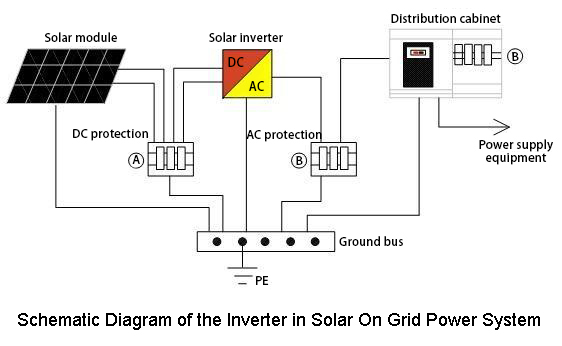Investing in a solar inverter for an on-grid system is a significant step towards harnessing renewable energy and reducing your electricity bills. An on-grid, or grid-tied, solar system is connected to the public electricity grid and allows you to export excess power generated back to the grid. Solar inverter is a main device and important part of PV on grid power system. In order to ensure the normal operation of the solar PV grid tie system, the correct configuration and selection of solar inverters are particularly important. For the configuration of the solar inverter, in addition to considering the technical specifications of the entire photovoltaic power generation system and referring to the product manual, the following technical features should also be considered.

1. Rated Output Power of the Solar Inverter
The rated output power represents the ability of the solar inverter to supply power to the load. Solar inverters with high rated output power can carry more electrical loads. When selecting a solar inverter, the first consideration should be that the inverter should have sufficient rated power to meet the electrical power requirements of the equipment under the maximum load, as well as the expansion of the system and the access of some temporary loads. When the electrical equipment is living on pure resistive load, or its power factor is greater than 0.9, the selected rated output power of solar inverter should be 10%~15% higher than the total power of the electrical equipment.
Several factors influence the rated output power of a solar inverter, including its design, efficiency, and the cooling mechanism employed. The inverter's efficiency, often between 95-98%, determines how much of the DC power is converted into usable AC power. Choosing the right rated output power involves considering the total capacity of the solar array, the energy consumption patterns, and future expansion plans. Proper sizing ensures optimal performance, efficiency, and longevity of the solar power system, contributing to the overall effectiveness and return on investment of solar installations.
2. Output Voltage Adjustability of the Solar Inverter
Adjustment performance of the output voltage represents the ability of the solar inverter to stabilize its output voltage. Generally, solar inverter products show the percentage of fluctuation deviation of the output voltage of the solar inverter when the DC input voltage changes within the allowable fluctuation range. Usually, this percentage is called the voltage regulation rate. High-performance solar inverters should also provide the percentage deviation of the output voltage of the solar inverter when the load changes from 0 to 100%. This percentage is usually called the load regulation rate. The voltage regulation rate of a solar inverter with good performance should be less than or equal to ±3%, and the load regulation rate should be less than or equal to ±6%.
Adjustable output voltage enhances system flexibility, allowing integration with various types of batteries, electrical grids, and off-grid systems. It also helps in optimizing the performance of the solar system, improving energy efficiency, and ensuring the safety of electrical appliances. This feature is particularly beneficial in regions with unstable grid voltages, as it helps in mitigating potential issues related to voltage fluctuations and ensures reliable power supply
3. Overall Efficiency of the Solar Inverter
The overall efficiency represents the power loss of the solar inverter itself. Larger capacity solar inverters should also provide efficiency values under full load and low load operation. In general, the efficiency of inverters below the kW class should be 80%~85%. The efficiency of a 10kW grid tie solar inverter should be 85%~90%. The efficiency of more power must be above 90%~95%. Efficiency of the solar inverter has an important impact on the solar on grid power system to increase the effective power generation and reduce the cost of power generation.
Several factors influence the efficiency of a solar inverter. These include the inverter's design, quality of components, and operating conditions. Modern inverters often use advanced technologies like Maximum Power Point Tracking (MPPT) to optimize the power output from solar panels under varying sunlight conditions, further enhancing efficiency.
Efficiency also depends on the inverter's load. Inverters operate most efficiently at or near their rated capacity. Under low load conditions, efficiency can drop significantly. Additionally, environmental factors such as temperature can affect performance; excessive heat can reduce efficiency, which is why adequate cooling and ventilation are crucial. Choosing a high-efficiency inverter can significantly impact the overall energy yield of a solar power system, making it a vital consideration for both residential and commercial solar installations. Therefore, when choosing a solar inverter, it is necessary to compare as much as possible, and then choose a product with a higher overall efficiency.
4. Start-Up Performance of the Solar Inverter
Solar inverter should be guaranteed to start reliably under rated load. The high-performance solar inverter can be started at full load multiple times without damaging the power switching devices and other circuits. For their own safety, small inverters sometimes adopt soft start or current limiting start measures or circuits.
The start-up performance of a grid tie solar inverter is critical for ensuring efficient energy conversion and system reliability. When a solar inverter starts up, it typically undergoes several key steps to transition from a non-operational state to full operation. Initially, the inverter conducts self-diagnostic checks to ensure all internal components and circuits are functioning correctly. This includes verifying grid connection parameters and the status of the DC input from the solar panels.
Once diagnostics are cleared, the inverter synchronizes with the grid frequency and voltage. This synchronization is crucial to ensure that the inverter's output is compatible with the grid to prevent damage and ensure safety. During this phase, the inverter may operate in a low-power mode to gradually ramp up and avoid sudden surges that could destabilize the grid or the inverter itself. Efficiency at start-up is influenced by factors such as ambient temperature, solar irradiance levels, and the quality of the inverter's components. High-quality inverters typically have faster and more reliable start-up times, enabling quicker transitions from night or cloudy conditions to energy production.

Summary
When buying a solar inverter, the first consideration is the scale of the PV on grid power station. You need to determine whether it is used in the home or in the business. In some places, solar panels cannot be installed due to the structural conditions of the houses, but they are still very advantageous for factories and enterprises. Small family PV on grid power plants are mainly installed for villas. Inverter.com provides different grid tie inverters to suit various occasions.
The second consideration is efficiency. Efficiency is directly linked to power generation.
Finally, reliability should be considered. Photovoltaic grid tie power system is a system that converts the direct current generated by solar cells into alternating current with the same frequency and phase as the grid voltage, and realizes both power supply to the load and power generation to the grid. The PV on grid power system is mainly composed of photovoltaic arrays, solar grid tie inverters, controllers and relay protection devices. The PV array is the main component of the solar on grid power system, which directly converts the received solar energy into electrical energy. At present, photovoltaic arrays used in engineering are generally composed of a certain number of crystalline silicon solar cell modules in series and parallel according to the voltage requirements of the system.
